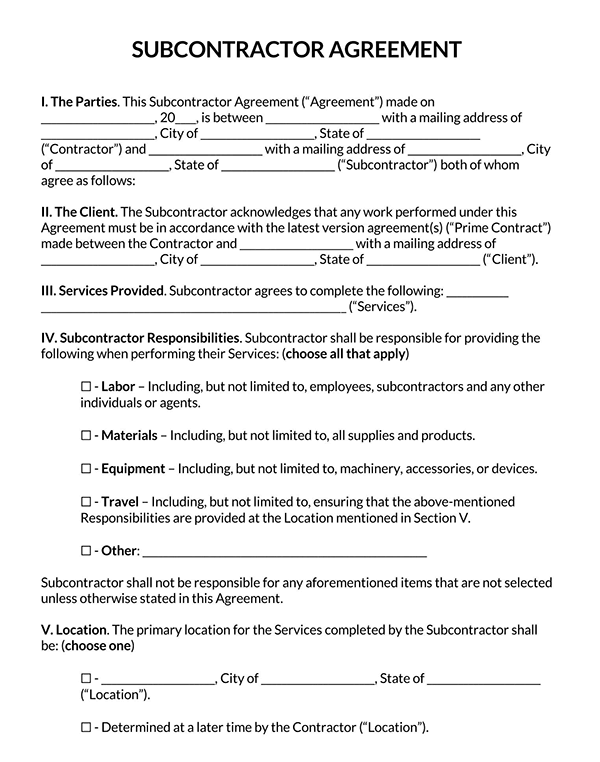A Subcontractor Agreement is a written contract that legally binds a contractor or project manager and a subcontractor hired to complete certain tasks or offer specific services.
Contractors can sometimes be limited by the scope of work, personal license restrictions, time, and other limitations that might prompt the need for assistance.
A subcontractor agreement template is a fillable document that contains all the fundamental sections that should appear in a standard subcontractor agreement. These fundamental sections are the scope of work, compensation, contractual terms and clauses, and completion deadlines. The template is prepared in such a way that it can be personalized to suit a specific industry or project.
Purpose of Subcontractor Agreement
A subcontractor agreement outlines a subcontractor’s responsibilities, terms of employment, the scope of work, liabilities, compensation, and details of the subcontractor and the contractor. The agreement outlines all the relevant information related to a project or work to be done. Therefore, it offers the subcontractor legal protection by giving them the leeway to accept or reject risks associated with the project. By defining the contractual obligations of each party, the agreement defines who is liable for what in the scope of work.
Subcontractor Laws and Taxes
State and federal laws govern subcontractor agreements. As a result, they are subject to variation from one state to another. Subcontractors, when filing taxes, require IRS Form W-9 indicating their name, social security number (SSN), or Employer Identification Number (EIN) as proof that they are allowed to work as subcontractors.
Additionally, subcontractors must be presented a completed IRS Form 1099-MISC by their contractor if they were compensated for payments worth more than $600 during the fiscal year. The contractor ought to present this document by 31st January of the following year, and it ought to be filed with the IRS by the last day of February.
Note: The IRS has defined who is a subcontractor and lawfully allowed to use the title. The definition of a subcontractor as per the IRS is like that of an independent contractor. However, a subcontractor works for other contractors or employers but is not a direct employee of the same. Additionally, subcontractors are termed self-employed taxpayers and therefore obligated to pay their state and federal withholding taxes.
Free Templates
Following are free downloadable subcontractor agreement templates for you:
Subcontractor agreement templates – by type
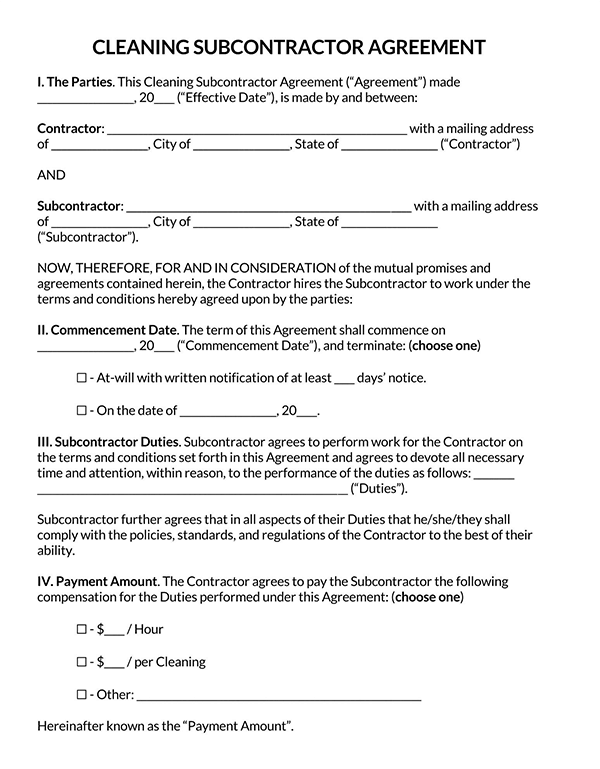
Cleaning Subcontractor
This type of subcontractor agreement is used when a person or entity hires a subcontractor for cleaning services and the scope of work involved. It is in commercial and residential properties. It outlines the payments terms – for example, per hour or wage or full-time pay – uniform and supplies and cleaning equipment requirements for the job.
Download: Microsoft Word (.docx)
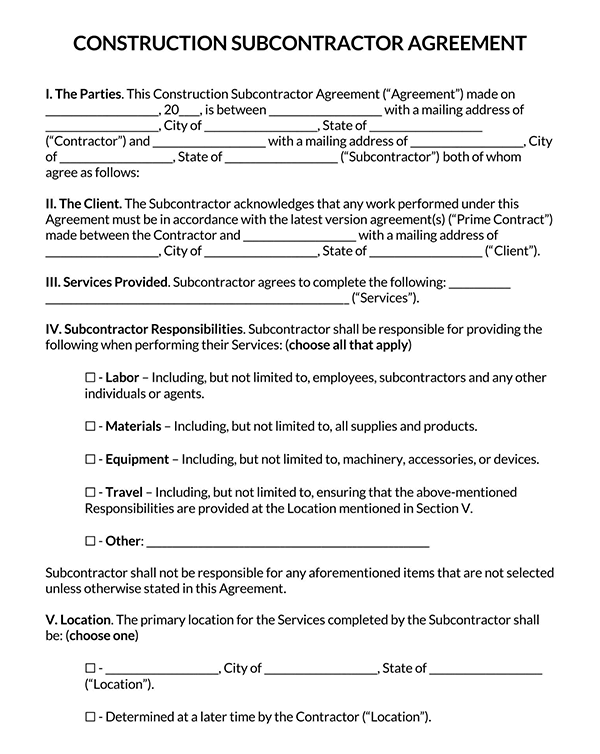
Construction Subcontractor
This subcontractor agreement is used when construction contractors cannot perform the task themselves and instead hire subcontractors such as electricians, plumbers, interior designers to perform specific services.
Download: Microsoft Word (.docx)
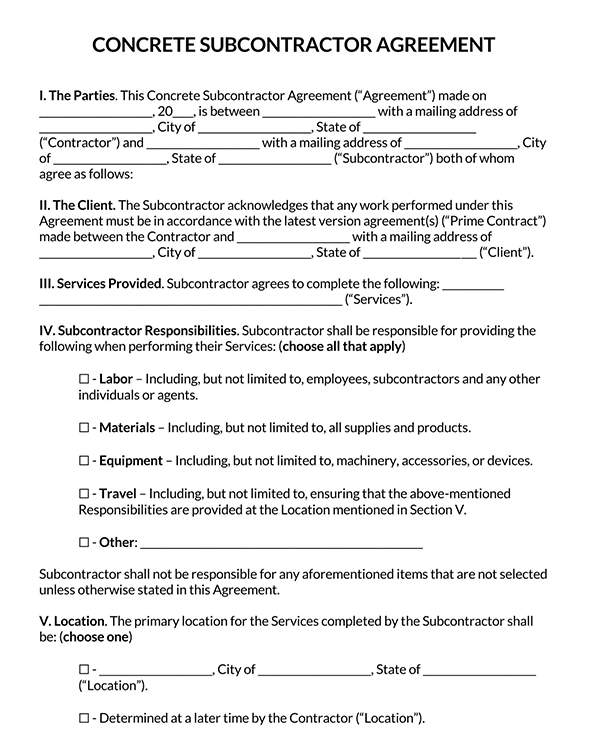
Concrete Subcontractor
A concrete subcontractor agreement is used to hire concrete specialists to undertake concrete works needed in a construction site, for example, specialists in building pavements, flooring, resurfacing, tiling, etc.
Download: Microsoft Word (.docx)
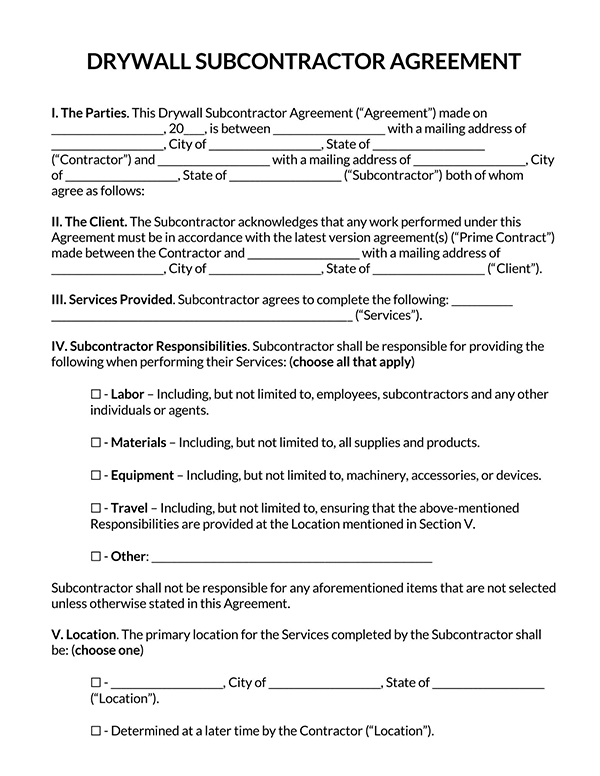
Drywall Subcontractor
This specific type of subcontractor agreement is used to hire specialists in drywall or plasterboard for walls and ceilings. Drywall is an important finishing aspect of buildings. This subcontractor agreement type outlines the scope of work, site, material requirements, costs, due date, liabilities, payment terms, and any other relevant details. Payment can either be during the work or a one-time payment once the job is done; this often depends on the size of the project.
Download: Microsoft Word (.docx)
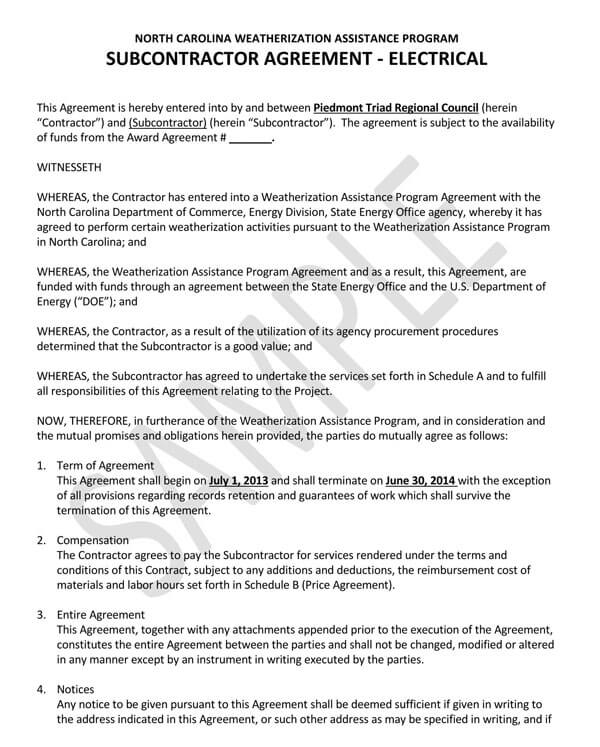
Electrical Subcontractor
An electrical subcontractor agreement is a type of agreement that employers use to hire electrical services such as installing electrical systems, wiring, lighting, repairing electrical equipment, etc.
Download: Microsoft Word (.docx)
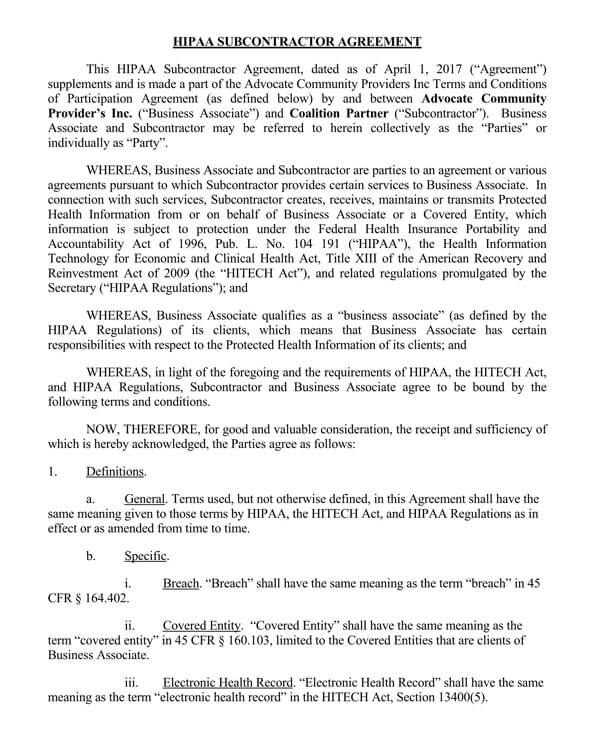
HIPAA Subcontractor
A HIPAA subcontractor agreement is used by businesses to assign an entity or individual the responsibility to receive, store or create information related to the HIPAA act on their behalf.
Download: Microsoft Word (.docx)
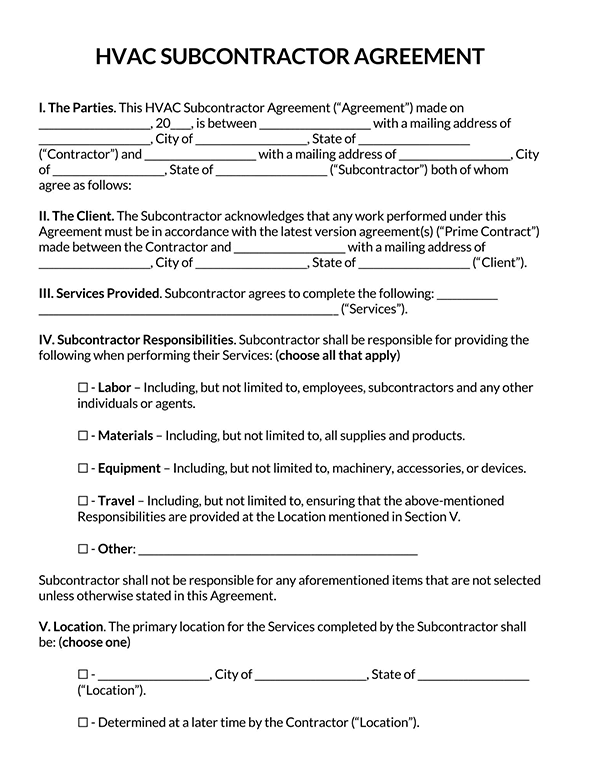
HVAC Subcontractor
An HVAC subcontractor agreement is used to hire specialists in heating, ventilation, and air conditioning units in a building. This type of subcontractor agreement is common in both residential and commercial buildings.
Download: Microsoft Word (.docx)
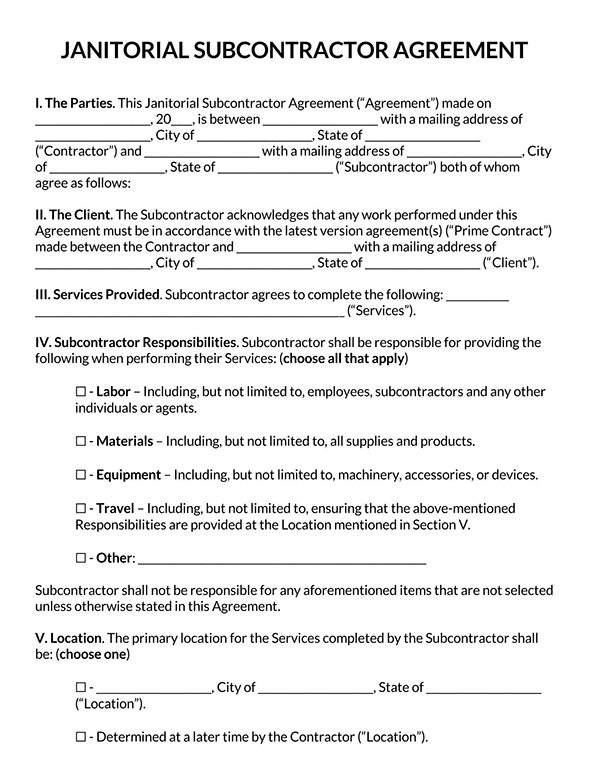
Janitorial Subcontractor
A janitorial subcontractor agreement is one that outlines the scope of work, payment terms, work duration, and payment offered for sub-contractual janitorial services in a building. It stipulates the scope of the work (services), payment amount, duration of the job, and completion date. A janitor subcontractor can be hired on a case-by-case or for a project. He or she is then responsible for paying their applicable state and federal taxes.
Download: Microsoft Word (.docx)
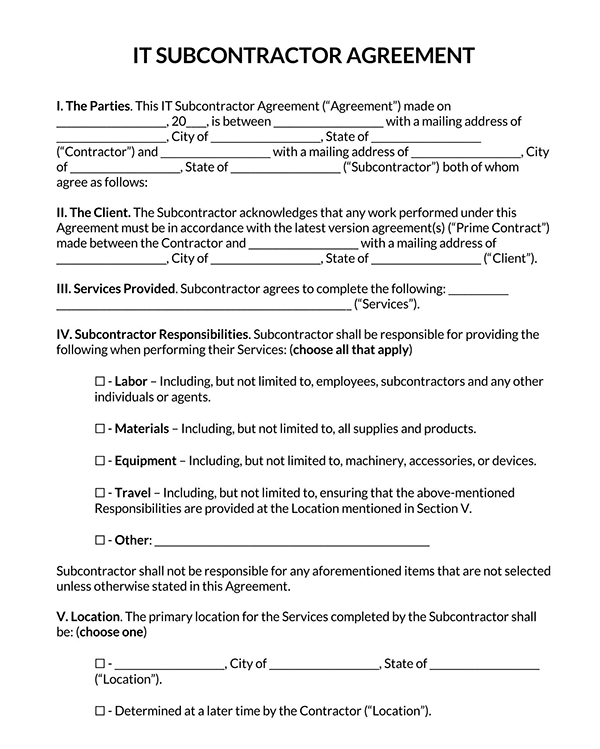
IT Subcontractor
An IT subcontractor agreement is used to hire Information Technology experts to assist with IT works in a project. Such subcontractors are associated with data analysis, programming, hardware development and maintenance, IT infrastructure design, etc.
Download: Microsoft Word (.docx)
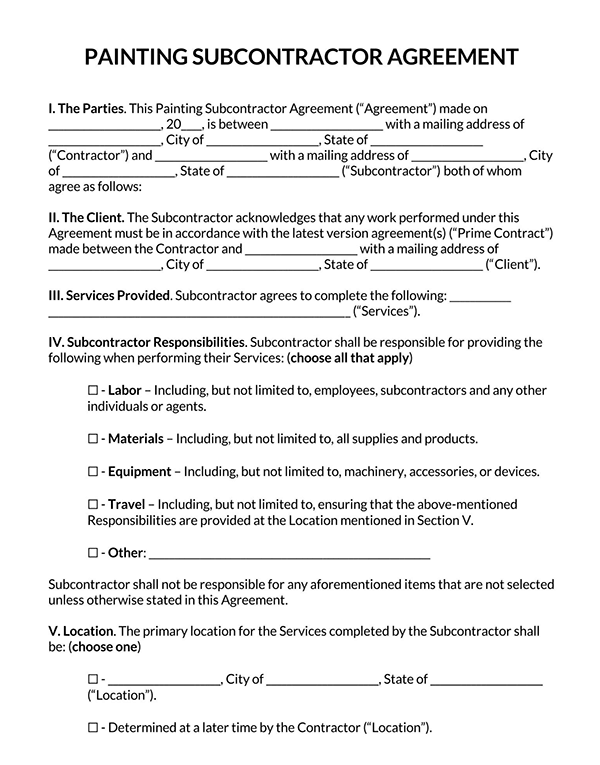
Painting Subcontractor
A painting subcontractor agreement is used to hire painting specialists for new constructions or during remodeling. It is often used when the painting works are a small portion of a larger project.
Download: Microsoft Word (.docx)
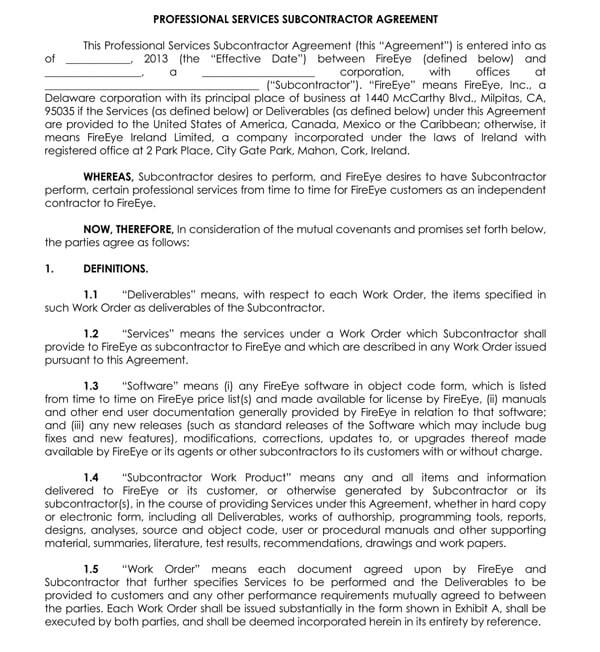
Professional Services Subcontractor
A professional type of subcontractor agreement is used to hire professional specialists in different industries such as programmers, plumbers, delivery services, etc., that simply cannot be done by one party alone.
Download: Microsoft Word (.docx)
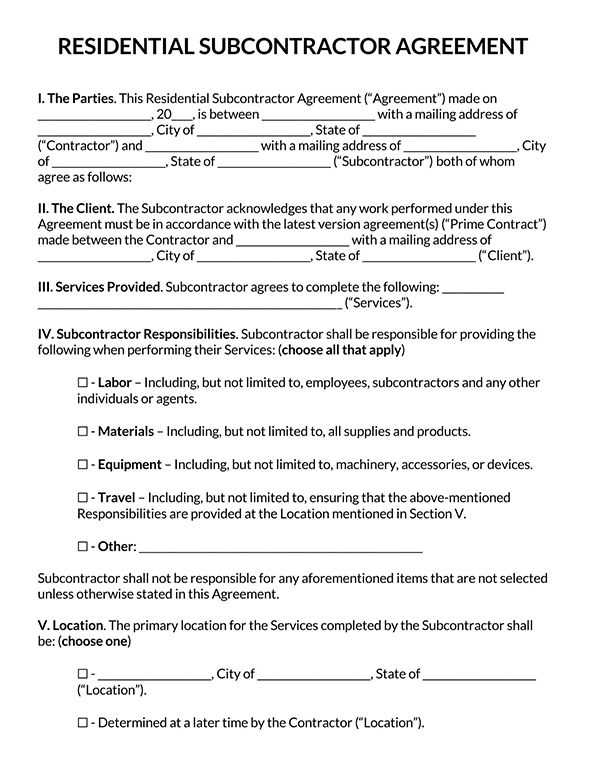
Residential Subcontractor
A residential subcontractor agreement is an agreement used by residential homes contractors to hire subcontractors to assist with works within the residential building. Common types of works done by residential subcontractors are renovations, construction, or any other work that might require a third party to partake in.
Download: Microsoft Word (.docx)
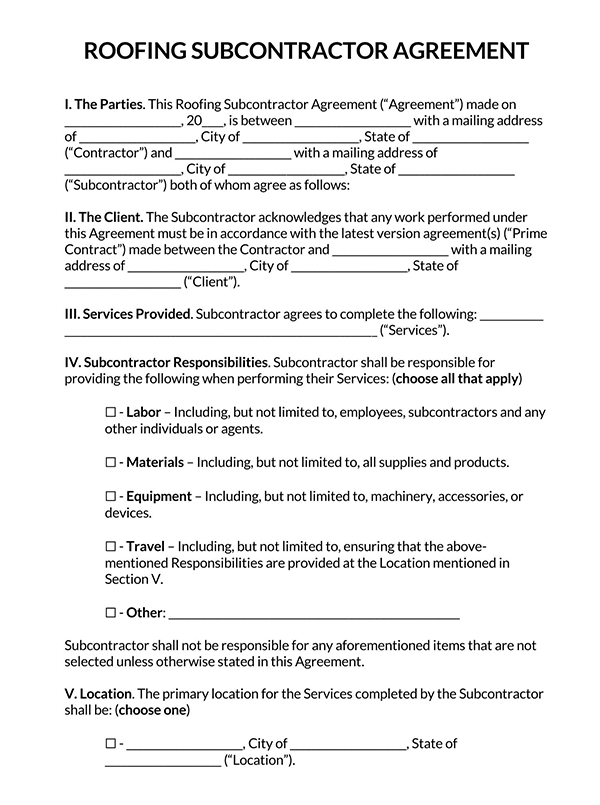
Roofing Subcontractor
A roofing subcontractor agreement is a type of agreement used to hire subcontractors that specialize in roofing works. Roofing is intricate and will often require a specialist to be obtained in any project. Payments of a roofing subcontractor can either be periodic (monthly or weekly) or after completing the work.
Download: Microsoft Word (.docx)
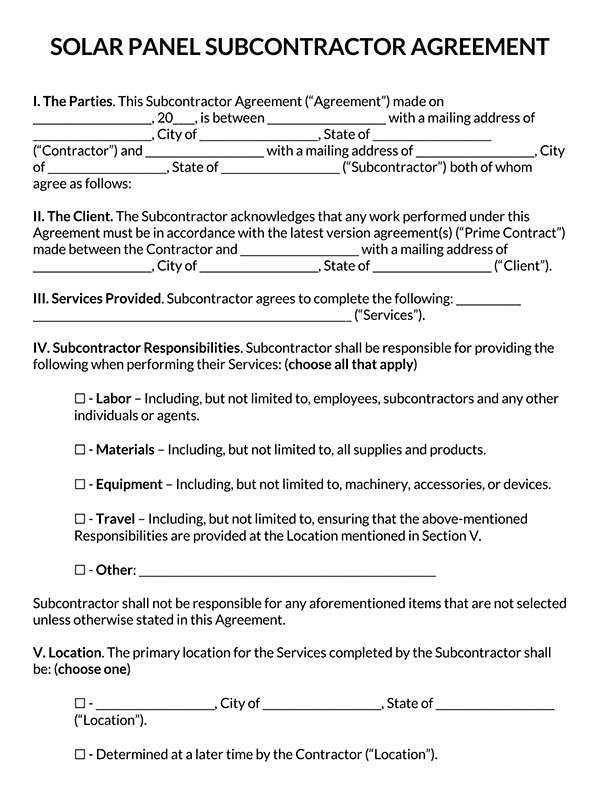
Solar Panel Subcontractor
A solar panel subcontractor agreement is used by solar panel installation services provider companies. The roofing specialist will often employ solar panel subcontractors, but the initial contractor can also hire the solar panel specialist.
Download: Microsoft Word (.docx)
Standard subcontractor agreement template
By U.S States
Who Uses a Subcontractor Agreement
Subcontractors can work for a broad range category of employers. These can be individuals or entities.
The following are examples of employers who need the services of subcontractors:
- Commercial property owners – Subcontractors can be hired for services such as running diagnostics of building systems, repairing HVAC systems, etc. Since they are not services that are needed every day of the year, commercial property owners use subcontractors to do the work for periodic durations.
- Construction contractors – Construction is multi-faceted; construction project managers hire subcontractors to complete specific tasks such as fabrication of parts, electricians, landscapers, etc.
- Contractors – Anytime a contractor employs another person or entity to complete a task assigned, that person or entity becomes a subcontractor.
- Corporations – Corporations hire subcontractors for a wide range of services such as data analysis, market research, and other services like brand promotion.
- Ecommerce operators – Ecommerce operators need subcontractors to market their products, packaging, delivery services, information storage, data security services, etc. If a customer orders a product from an eCommerce operator, the eCommerce operator hires a subcontractor to make the delivery. Typically, the eCommerce and the delivery service operator enter into a subcontractor agreement.
- Entrepreneurs and sole properties – Businesses sometimes have to hire subcontractors to complete work designated to them by customers. This is seen especially when work has to be distributed among different subcontractors in order to meet deadlines.
- Home owners – Homeowners use subcontractors for works such as security, cleaning, landscaping, etc. Companies that provide these services hire subcontractors to work for the homeowners.
- Independent contractors hiring other subcontractors – Independent contractors are known to use subcontractors in an effort to get more work done in short durations. This reduces delays in project execution and backlogs.
- Individuals seeking to hire subcontractors – Individuals such as employees have been known to use subcontractors to complete tasks assigned to them. For example, a journalist hiring an independent investigator to collect information on a specific event.
- Lawyers – Lawyers use subcontractors such as data analysts, auditors, forensics, etc., to gather evidence to make their case.
- Limited liability corporations – When an LLC physically hires a registered agent to represent them in a state or region, the registered agent becomes a subcontractor to the LLC.
- Small business owners – Small business owners hire subcontractors to complete one-time tasks such as delivering a product to a new region the business does not operate in. web designers used to create websites are also examples of subcontractors.
Difference B/W a Contractor and a Subcontractor
Contractors are known to obtain contracts and complete projects for employers. In contrast, subcontractors are known to perform specific work of the project on a contractual basis – a contractor’s work is more generic while a subcontractor’s work is specific. In addition, a contractor employs a subcontractor, and a contractor is hired by a direct employer/customer or investor.
For example:
An engineer to a construction site is a contractor while the businesses and individuals he or she hires for activities such as fabricators, electricians are subcontractors. Contractors oversee subcontractors. The contractor can be termed as a system while the subcontractors are the moving parts. They both work towards the same goal.
Difference B/W an Employee and Subcontractor
Although the terms subcontractor and employee might seem interchangeable, they are different. The primary difference is that a subcontractor is self-employed by employment law, while an employee is precisely that, an employee.
The differences between subcontractors and employees can be further discussed in the following ways:
Responsibilities
A subcontractor is hired to complete project tasks that a contractor cannot do themselves in terms of responsibilities. On the other hand, an employee on the employer’s payroll is typically bound to their responsibilities for a long period than a subcontractor. Also, an employee is typically bound by their employment agreement and do not have the flexibility to accept or reject responsibilities assigned to them.
Taxes
Subcontractors are solely responsible for their own taxes, health benefits, supplies, etc. They are supposed to declare their income to the IRS and file accordingly. On the other hand, an employee has their employment-related taxes automatically withheld by their employer. As a result, they may be entitled to health benefits, work supplies, equipment, sick days, etc.
Payment
Subcontractors are paid after their job is completed, whereas an employee is paid on a consistent periodic basis, such as monthly. An employee is compensated for their work based on company policies and, as a result, will usually be entitled to a fixed hourly wage or a salaried amount. On the other hand, a subcontractor negotiates their compensation with the contractor and can therefore be paid different figures for the same job.
Behavior
The employer’s guidelines and policies bind employees, and they are expected to conduct their job duties in a stipulated manner. Subcontractors have more freedom and are expected to conduct their duties themselves professionally and are bound by industry standards. In addition, an employee works for one employer, while a subcontractor can work for multiple contractors.
Key Elements of a Subcontractor Agreement
For a subcontractor agreement to effectively define what a subcontractor should do and effectively protect him or her from liabilities, certain key elements must be included in the agreement.
They include:
Parties to the agreement
The agreement must identify the parties bound by the document. The primarily involved parties are the subcontractor and the contractor.
Effective date
A subcontractor agreement must be dated. Therefore, the document’s effective date must be indicated to show the parties involved are bound by the agreement from the said date up to the expiration of the contract.
Scope of work
The work assigned to the subcontractor must be defined. This makes up the scope of the work section. The scope lists the tasks, key performance indicators, and standards that the subcontractor has been assigned to complete on behalf of the contractor. The deliverables must be specific in order for success can be measured.
Payment and billing clause
This clause in the subcontractor agreement stipulates how the subcontractor will be compensated for their work/services. Compensation will depend on the scope of work as well as the basic labor laws. It is usually as follows; hourly, weekly, bi-weekly, monthly, or lump sum.
Payment terms should stipulate the maximum working hours the subcontractor should complete weekly or monthly, payment milestones, expected time of issuing invoices, terms of extension of the subcontract, and flexibility of payment (fixed or flexible). If an extension is necessary, compensation should be declared accordingly.
Supply chain
The agreement should clearly define the supply chain risks transferable to the subcontractor. The supply chain outlines the employer’s specific requirements. The agreement’s supply chain is negotiable. Subcontractors should aim to mitigate this risk as much as possible.
Defense and indemnification
A defense and indemnification clause is added to a subcontractor as a mitigation measure (insurance) for the contractor against loss, damage, and other risks. Subcontractors should aim to reduce their liability as it can be costly. Some states have laws that protect subcontractors from unmerited defense and indemnification clauses.
To defend is defined as the duty to actively defend or fund the defense of a claim brought by the employer against the contractor. To indemnify implies to impose the obligation to pay or compensate the contractor for certain liabilities or losses should they occur.
Insurance, bonds, and liens
The agreement should outline any applicable insurance, bonds, or liens associated with the works assigned to them. Different works in a project require different insurances; the agreements should declare which party is to cover which insurance.
For example:
General liability insurance for worker’s compensation in case of injuries.
Liens are other third parties with a claim or stake in executing tasks assigned to the subcontractor.
For example:
A machinery lien.
Assignment provision
An assignment provision outlines if a subcontractor is permitted by the agreement to assign their contractual obligations to another party. More often than not, this provision will be prohibited by the agreement.
Non-disclosure agreement
The NDA disclosure outlines any information related to the project, the contractor, or the employer the subcontractor is expected to keep confidential. This agreement is guided by the Master Agreement between the contractor and the employer. It also outlines the consequences of breaching this agreement.
Non-complete clause
A non-complete disclosure states that the work the subcontractor is given does not conflict with any other project the subcontractor might have or is involved with contractually. It also prevents the subcontractor from undertaking any action to pursue the contractor’s clientele by offering lower quotations etc. A non-compete clause lists the applicable contractual consequences of undertaking conflict of interest actions.
Warranty
The subcontractor agreement ought to state that the subcontractor guarantees to deliver up to standard results free from avoidable defects.
Subcontractors are often required to warranty the following;
- Work quality
- Professional ethics
- Tools, skills, and knowledge to undertake the assigned responsibilities
- To resolve any defects in the deliverables
- Complete the tasks in the allocated time frame etc
Arbitration
An arbitration clause is added to declare the resolution approach that each party should take in case of any disputes and the legal procedures adopted in such a case. This clause will often limit the subcontractor from pursuing legal actions before trying negotiation and mediation/arbitration.
Conditional payment
A conditional clause declares that a contractor will only pay the subcontractor if the employer pays them. Basically, is a “pay when/if paid” clause. This section might result in delays in compensation and must therefore be keenly considered before a subcontractor signs the agreement.
Benefits that are NOT provided in the Agreement
Subcontractors being self-employed, are limited in terms of the benefits they enjoy from employment.
Some of the benefits not provided to subcontractors are:
- Employment benefits – A subcontractor agreement does not award the subcontractor employment benefits such as health, paid time off, sick days, pension (401K), and more. Workers under the subcontractors are not entitled to the same benefits. However, the subcontractor must be registered with the IRS as a subcontractor.
- Supplies and tools – A qualified subcontractor ought to have the ability to obtain or have the supplies and tools required to complete the work given to them. The agreement should not require the contractor to provide additional materials.
- Tax payment – The subcontractor obligates the subcontractor to pay taxes as a self-employed individual or entity. Therefore, the subcontractor should be paid the total amount with no amount withheld by the contractor.
- Training – The subcontractor agreement does not entitle the subcontractor to any training by the contractor for the job to be done. It is expected that the subcontractor is fully equipped and trained to carry out the laid-out responsibilities.
Subcontractor Agreement State Laws
There are some laws that are applicable to subcontractor agreements; according to States.
They are provided below:
| AL – § 34-8-1(c) | MT – § 28-2-2101(9) |
| AK – AS 23.20.526 | NE – § 45-1202(6) |
| AZ – ARS 32-1101(3)(b) | NV – NRS 40.630 |
| AR – § 18-44-107(4) | NH – § 281-A:2(IV) |
| CA – § 2782.05(i) | NJ – § 2a-44a-2 |
| CO – § 24-91-102(4) | NM – § 60-13-3(A-B) |
| CT – § 4e-1(29) | NY – § 756(4) |
| DE – § 2501(8) | NC – § 22C-1(6) |
| FL – § 713.01(28) | ND – § 35-27-01(7) |
| GA – § 13-10-80(a)(5) | OH – § 1311.01(D) |
| HI – § 444-1 | OK – § 61-222(7-8) |
| ID – § 72-102(13)(a) | OR – § 701.410(1)(d) |
| IL – 720 ILCS 5/33E-2(k) | PA – § 1201(5) |
| IN – § 5-16-5.5-1 | RI – No specific statutory definition. |
| IA – § 572.1(11) | SC – § 29-6-10(6) |
| KS – § 16-1802(h) | SD – § 43-07-01(1) |
| KY – § 45.560(4) | TN – § 62-6-102(4)(A)(ii) |
| LA – R.S. 37:2150.1(13)(a) | TX – § 28.001(B)(6) |
| ME – 39-A §105-A(1)(B) | UT – § 38-1a-102(33) |
| MD – § 8–101(o) | VT – § 4001(6) |
| MA – MGL c.142A § 1 | VA – VA Code § 2.2-4347 |
| MI – § 570.1106(5) | WA – § RCW 18.27.010(12) |
| MN – § 161.321(1)(c) | WV – § 21-11-3(q) |
| MS – 35.IV.10.01(102) | WI – § 66.0901(1)(d) |
| MO – § 292.675(8) | WY – § 39-16-301(vi) |
Final Words
A subcontractor agreement is a written document used to outline a subcontractor’s work assigned to complete by a contractor. It is legally binding. There are different types of subcontractor agreements depending on the type of project and industry. Subcontractors are considered self-employed individuals or entities per the law. When crafting a subcontractor agreement, one can use a template that suits their specific scope of work and project.
